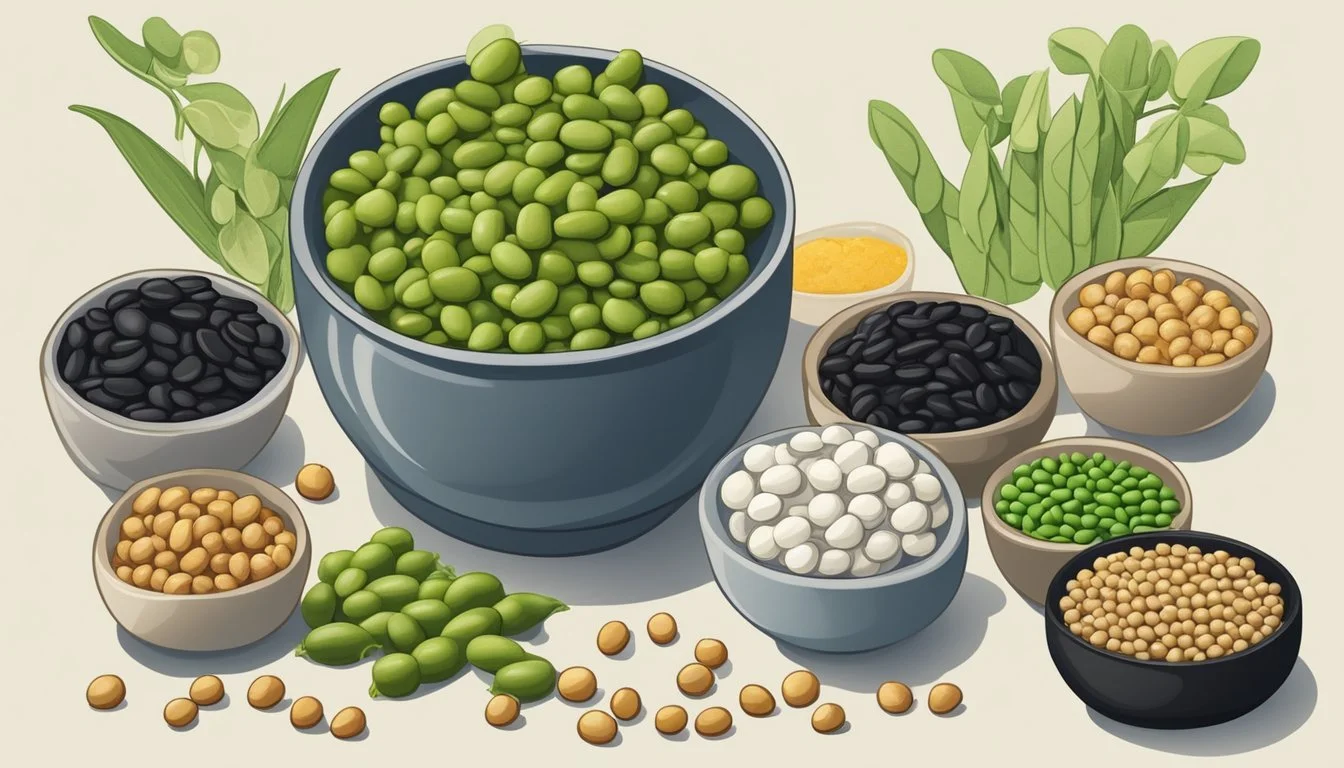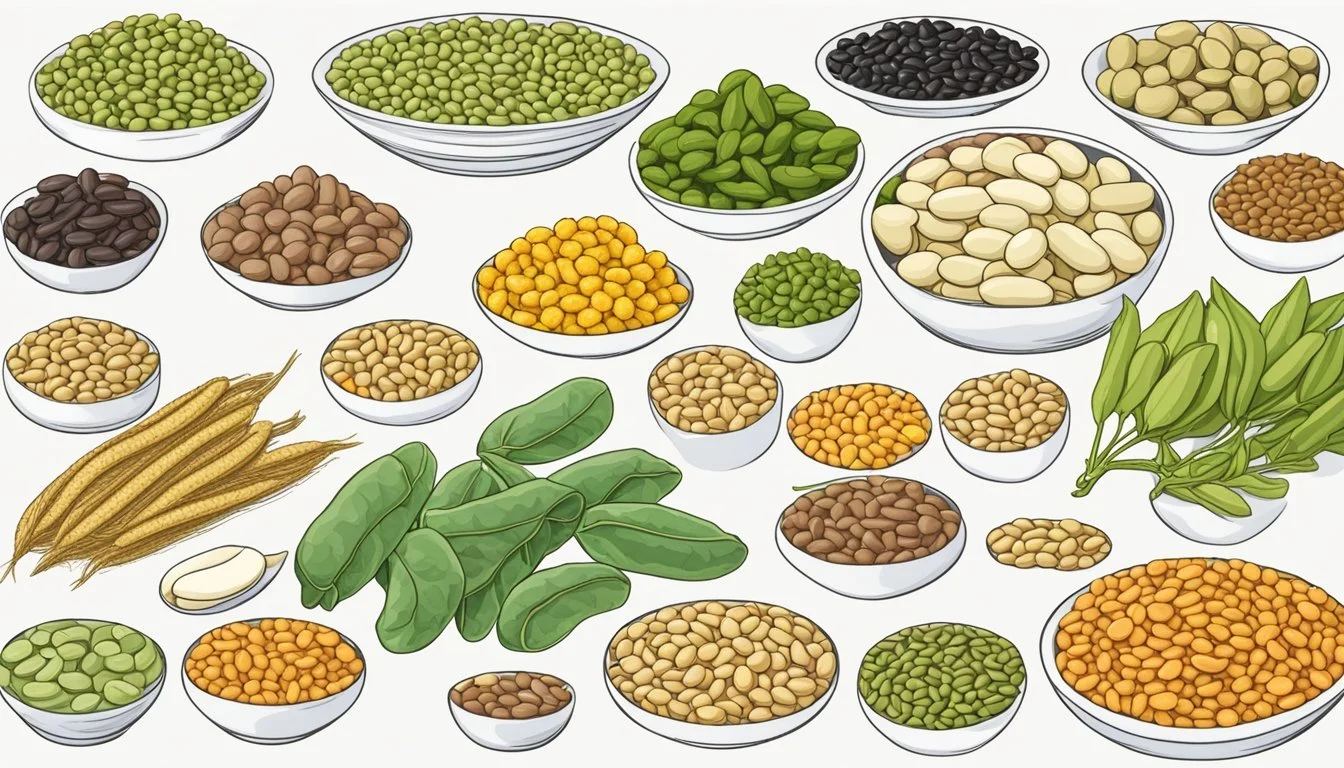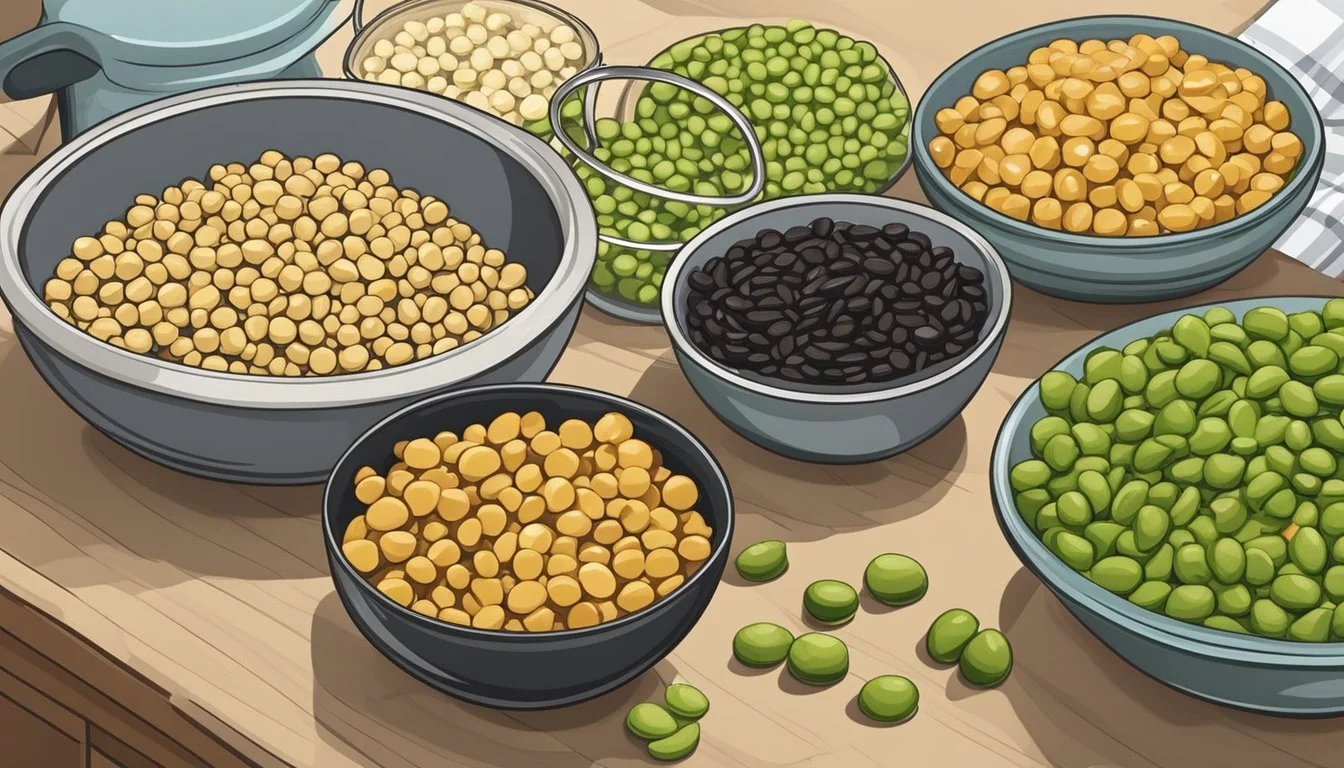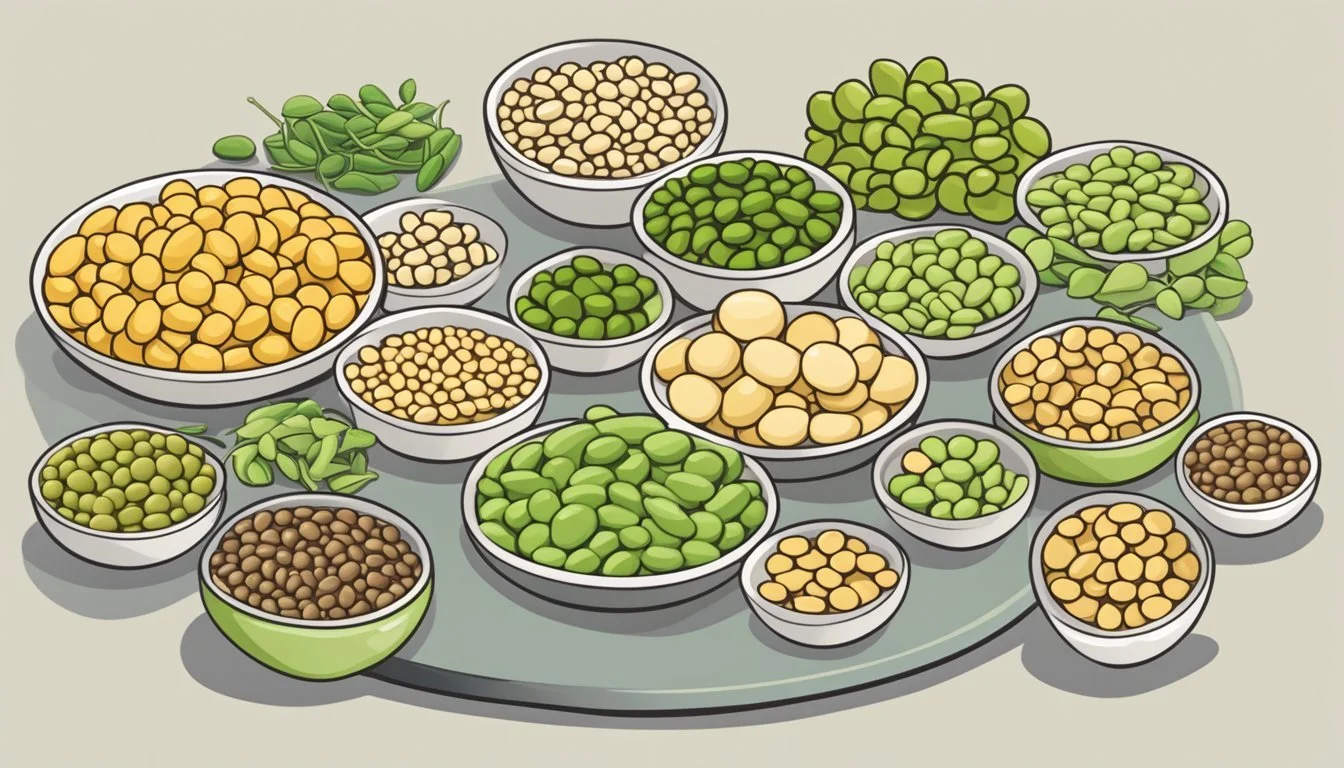Lima Beans Substitutes
Best Alternatives for Your Recipes
Lima beans are a versatile ingredient, but sometimes they can be difficult to find or perhaps not to everyone's taste. When you find yourself in need of a substitute for lima beans, red kidney beans come highly recommended. Their rich, earthy flavor adds depth to any dish, and they maintain their structure well during cooking, making them perfect for stews and salads.
Fava beans, with a similar texture and taste to lima beans, also make an excellent alternative. Whether used in succotash or a hearty bean stew, fava beans' smooth shape and indulgent taste can enhance a variety of dishes seamlessly.
Pinto beans are another great option, particularly in baking recipes, stews, salads, and stir-fries. They bring a subtle, creamy flavor that can complement many recipes, making them a good replacement for lima beans when needed.
Understanding Lima Beans
Lima beans are a nutritious addition to many diets and serve as a staple ingredient in a variety of cuisines. They offer several health benefits and can be used in diverse culinary preparations.
Nutritional Profile
Lima beans are rich in fiber and protein, making them an excellent choice for maintaining a balanced diet. A serving of lima beans provides a substantial amount of iron and folate, essential nutrients for overall health. The high fiber content aids in digestion and helps lower cholesterol levels. Additionally, lima beans are low in fat, which makes them a heart-friendly food option.
Nutritional components in lima beans include:
Fiber: Supports digestive health
Protein: Essential for muscle repair and growth
Iron: Vital for blood health
Folate: Important for cell division and growth
Culinary Uses
In the culinary world, lima beans are versatile and can be found in various dishes. They are commonly added to stews, soups, and salads. Their creamy texture complements dishes like succotash and can be used to thicken soups without the need for cream.
Lima beans pair well with:
Vegetables: Such as tomatoes, corn, and peppers
Proteins: Including ham, bacon, and chicken
Herbs and Spices: Like parsley, thyme, and garlic
Cooking methods include boiling, simmering, and mashing, making them adaptable to both savory and sweet dishes. Whether they're featured as a main ingredient or a side dish, lima beans add a nutritional boost and unique flavor to meals.
Choosing Lima Bean Substitutes
When selecting substitutes for lima beans, consider both the flavor and the texture of the alternatives to find a suitable match for your recipes. The following factors and substitution ratios will help guide your choice.
Factors to Consider
One important factor to assess is the texture of the substitute. Lima beans are known for their creamy texture, so choosing beans like butter beans or fava beans will replicate this aspect well in your dishes. For stews and soups, navy beans or pinto beans can also serve as good alternatives due to their similar consistency.
Another key factor is the flavor profile. Fava beans and butter beans have a comparable nutty flavor, which makes them excellent substitutes in terms of taste. If nutritional match is a concern, look to beans high in protein and fiber, such as kidney beans and chickpeas.
An often overlooked consideration is the versatility of the substitute in various types of dishes. Red kidney beans work well in chilies, while white kidney beans are better suited for salads and side dishes. Also, the availability of some beans like edamame or cannellini beans can influence your choice, especially if they are easier to find in your local stores.
Substitution Ratios
Determining the correct substitution ratio ensures that your recipes maintain their intended balance. For most beans like butter beans and fava beans, you can use a 1:1 ratio. This means if a recipe calls for one cup of lima beans, you use one cup of the chosen substitute.
For smaller beans such as navy beans or pinto beans, you may need to adjust the ratio to account for their size and density. Typically, a 1:1.25 ratio works well, where one cup of lima beans would be substituted with 1.25 cups of these alternatives.
In dishes where the nutritional content is crucial, such as in vegetarian diets, consider using chickpeas or red kidney beans. These beans can be substituted at a 1:1 ratio, ensuring that the protein and fiber content remains similar to that of lima beans.
Using these guidelines, you can effectively choose and substitute lima beans in various culinary applications, ensuring your dishes remain delicious and balanced.
Top Lima Bean Alternatives
When looking for a suitable substitute for lima beans, you have multiple options to choose from. Several legumes offer similar textures, flavors, and versatility, making them excellent replacements in a variety of dishes.
Butter Beans
Butter beans, often considered the mature form of lima beans, have a creamy texture and mild flavor. These beans are ideal for soups, stews, and casseroles. They retain their shape well when cooked, adding both substance and a delicate taste. Butter beans also pair beautifully with robust spices, enhancing the overall dish without dominating it.
Fava Beans
Fava beans have a firm texture and a slightly earthy flavor, making them a worthy replacement for lima beans. They are rich in protein and fiber and can be used in a variety of dishes such as stews, salads, and pastas. You can find them both fresh and canned, offering versatility in cooking methods and recipe applications.
Cannellini Beans
Cannellini beans, also known as white kidney beans, have a smooth texture and a mild flavor. They absorb flavors well and work excellently in soups, stews, and salads. Their larger size and creamy consistency can make the dish heartier and more satisfying. Cannellini beans are also a good source of protein and fiber, fitting well into a balanced diet.
Great Northern Beans
Great Northern beans offer a mild, slightly nutty flavor and maintain their shape well during cooking. They are smaller than cannellini beans but similar in color and texture. These beans are suitable for slow-cooked recipes, salads, and casseroles, contributing a soft yet firm texture to the dish.
Navy Beans
Navy beans, also known as Boston beans or pea beans, are small and white with a smooth texture and mild flavor. They are incredibly versatile and can be used in baked dishes, soups, and stews. Navy beans provide a creamy consistency when cooked and can easily absorb the flavors of the ingredients they are paired with.
Chickpeas
Chickpeas, also known as garbanzo beans, have a firm texture and a slightly nutty flavor. They are versatile legumes that can be used in various dishes, including salads, stews, and stir-fries. Chickpeas are also the primary ingredient in hummus and can be roasted for a crunchy snack. They are a rich source of protein and fiber, making them a nutritious substitute.
Kidney Beans
Kidney beans, including both red and white varieties, offer a firm texture and a rich, earthy flavor. They are well-suited for slow-cooked dishes like chili, soups, and stews. Red kidney beans are particularly flavorful, adding a robust taste to any dish. Kidney beans are nutrient-dense, packed with protein, fiber, and essential vitamins.
Edamame
Edamame, or young soybeans, have a unique, slightly sweet flavor and firm texture. They are commonly used in Asian cuisine, often steamed and served as a snack or appetizer. Edamame can also be added to salads, stir-fries, and rice dishes. These beans are rich in protein and essential amino acids, making them a healthy and versatile option.
Each of these lima bean substitutes brings its own unique attributes to a dish, allowing for creativity and variety in cooking.
Lima Bean Substitutes in Specific Dishes
When substituting lima beans, the key is to choose alternatives that match the texture and flavor needed for the dish. This ensures that the consistency and taste of the recipe remain balanced.
In Soups and Stews
Pinto beans and navy beans are excellent alternatives for lima beans in soups and stews. Pinto beans offer a similar creamy texture when boiled, making them perfect for hearty dishes. Navy beans, also known as Boston beans, are another suitable option as they maintain their shape well during slow cooking. Fava beans can also be used for their smooth texture and rich flavor, though they may require longer cooking times.
In Salads
When looking for substitutes in salads, white kidney beans and black-eyed peas are top choices. White kidney beans provide a mild flavor and a consistent texture that pairs well with various ingredients. Black-eyed peas offer a slightly nutty taste that complements many salad dressings. For those seeking a gluten-free option, chickpeas are excellent as they uphold their structure without becoming mushy, adding a bit of firmness to your salad.
In Dips and Spreads
Fava beans stand out as the best choice for dips and spreads, thanks to their creamy consistency when blended. Cannellini beans can also serve as a robust alternative, providing a smooth and rich texture ideal for making hummus or other bean-based spreads. These beans are also rich in protein, making the dips not only tasty but also nutritious. Butter beans can be used for a velvety, creamy texture, enhancing the dip's overall mouthfeel.
In Baking
In baking recipes where lima beans might be used, pinto beans and red kidney beans can be effective substitutes. Pinto beans work well in baked dishes due to their creamy texture when pureed. Red kidney beans, although slightly firmer, can add a unique flavor profile when used in veggie burgers or bean-based desserts. For a gluten-free option, try garbanzo beans (chickpeas), which can be blended into a smooth batter suitable for cakes and other baked goods.
Special Dietary Considerations
When substituting lima beans, it's important to consider dietary restrictions such as vegan and vegetarian needs, gluten-free options, and potential food allergies. This ensures healthy and compatible alternatives for various dietary requirements.
Vegan and Vegetarian Choices
Red kidney beans and chickpeas are excellent substitutes for lima beans and fit well into both vegan and vegetarian diets. Both beans provide substantial protein and texture. Fava beans are also suitable and can be used in a wide range of dishes, adding a creamy texture without the use of animal products.
Lentils, especially red lentils, are another great option. They cook quickly and offer a rich, earthy flavor. These alternatives ensure that vegan and vegetarian eaters don't miss out on important nutrients or flavors in their meals.
Gluten-Free Alternatives
Lima bean substitutes like navy beans, black beans, and pinto beans are naturally gluten-free and work well for those with gluten intolerance or celiac disease. These beans can be seamlessly integrated into recipes such as soups, stews, and salads without any risk of gluten contamination.
Garbanzo beans (chickpeas) are also a safe and versatile gluten-free choice, suitable for making dishes like hummus or roasted chickpea snacks. Ensuring these alternatives are certified gluten-free when possible can provide added safety for sensitive individuals.
Allergy Considerations
When replacing lima beans, it is crucial to account for common legume allergies. Some individuals may be allergic to beans such as soybeans, peanuts, or lentils. Chickpeas and lentils, though nutritious, might cause reactions in some people.
Fava beans can also cause issues for individuals with G6PD deficiency, a genetic condition. In such cases, alternatives like canned peas or green beans might be safer. Consulting with an allergist about legume choices can ensure safe and healthy substitutions.
Lima Bean Substitutes from Around the World
When looking for substitutes for Lima beans, various regions offer unique alternatives that bring their own flavors and textures to the table. These substitutes not only serve as excellent replacements but also add nutritional benefits.
Mediterranean Options
Borlotti Beans are commonly used in Italian cuisine. They are rich in fiber, iron, and folate, making them a nutritious option. Their creamy texture makes them suitable for soups, stews, and salads.
Cannellini Beans are another staple in Italian dishes. Like Lima beans, they work well in soups and stews and can be used in a variety of Mediterranean recipes. Their mild flavor pairs well with herbs and garlic.
Middle Eastern Favorites
Fava Beans are a popular choice in Middle Eastern countries. Known for their firm texture and nutty taste, they are often used in dishes like falafel and ful medames.
Chickpeas are also widely used across this region. High in protein and fiber, they can replace Lima beans in stews and salads. Roasted chickpeas are commonly added to couscous and quinoa dishes for extra crunch.
Latin and South American Varieties
Pinto Beans are prevalent in Mexican cuisine. They can replace Lima beans in stews, soups, and salads. These beans are rich in magnesium and folate, contributing to their health benefits.
Red Kidney Beans are often used in the Andean region. With their dense, meaty texture and rich flavor, they hold up well in various dishes. They provide a good source of protein and iron, making them a robust alternative to Lima beans.
Asian Influences
Edamame or young soybeans are a staple in East Asian cuisines. Known for their high protein content, they can be used in salads and stir-fries in place of Lima beans.
Tofu is another versatile substitute. While not a bean, it is made from soybeans and can replace Lima beans in soups, stews, and casseroles. Silken tofu is ideal for creamy dishes, while firm tofu holds up well in hearty recipes.
Cooking Tips for Lima Bean Substitutes
When substituting lima beans, consider the preparation method of dry beans, the convenience of canned alternatives, and achieving the desired flavor and texture. These tips will help.
Preparing Dry Beans
When using dry beans as a substitute, soak them overnight. This step is essential for pinto beans, navy beans, and red kidney beans. To cook, drain the soaked beans, then simmer them in fresh water for 1-2 hours until tender.
Use a slow cooker to ease the process. Slow cooking is ideal for retaining the beans' texture in dishes like stews or baked beans. Season during the last 30 minutes to prevent toughening. Dry beans are high in fiber and low in cholesterol, making them a nutritious choice.
Using Canned Alternatives
Canned beans offer a quick and easy substitute. Opt for canned pinto beans, navy beans, or red kidney beans. Drain and rinse them to remove excess sodium. This also helps improve the flavor in your dish.
They are perfect for last-minute recipes. Canned beans are already cooked, so add them directly to salads, soups, or stir-fries. They cut down on cooking time and simplify meal prep, making them ideal for busy schedules.
Achieving the Right Flavor and Texture
To replace lima beans' creamy texture, consider using tofu. Silken tofu adds a smooth texture to soups and casseroles. For a nutty flavor, red kidney beans are excellent.
Fava beans can mimic the buttery flavor of lima beans. Adding a splash of olive oil or seasoning with smoked paprika enhances the taste of substitutes. Adjust cooking times based on the beans used. Proper seasoning and cooking method ensure substitutes match the intended use in various recipes.
Nutritional Comparisons
Lima bean substitutes offer a variety of nutritional benefits. Key factors like fiber and protein content, as well as differences in vitamins and minerals, play crucial roles in deciding which substitute to use.
Fiber and Protein Content
Fiber and protein are essential components in a balanced diet. Red kidney beans are a popular substitute high in fiber and protein. For every 100 grams, they provide approximately 8 grams of fiber and 15 grams of protein.
Pinto beans offer about 9 grams of fiber and 21 grams of protein per 100 grams, making them another excellent choice.
Navy beans also excel in this area, offering around 10 grams of fiber and 22 grams of protein per 100 grams. These beans are great for maintaining digestive health and muscle mass.
Quinoa, while not a bean, contains around 7 grams of protein and 2.8 grams of fiber per 100 grams. Its fiber content is lower, but it remains a good choice for those needing a gluten-free option.
Mineral and Vitamin Differences
Minerals and vitamins vary considerably between substitutes. Kidney beans are rich in iron and magnesium, offering around 21% and 12% of the Recommended Daily Allowance (RDA) per 100 grams, respectively.
Pinto beans provide significant amounts of folate and manganese, with about 74% and 30% of the RDA per 100 grams. Folate is crucial for cell production, while manganese supports bone health.
Navy beans have high levels of folate (64% RDA) and vitamin B6 (20% RDA).
Chickpeas offer beneficial amounts of vitamin B6 (15% RDA) and iron (26% RDA). Chickpeas are also low in cholesterol, aiding cardiovascular health.
Using these substitutes can diversify your nutrient intake, offering various advantages over traditional lima beans.
Conclusion
In summary, several substitutes can effectively replace lima beans in various recipes. Fava beans are notable for their subtly sweet taste and creamy texture. They are commonly used in Mediterranean and Middle Eastern dishes, adding a versatile element to your meals.
Red kidney beans offer a stronger flavor and are easy to cook. These beans can seamlessly fit into recipes like chili, stews, or salads, even if their color and taste differ from lima beans.
Navy beans and black beans also make good substitutes. Navy beans have a mild, nutty flavor and a creamy texture, while black beans add a richer, more complex taste. Both are easy to cook and versatile in many dishes.
Cannellini beans and pinto beans bring their unique qualities to the table. Cannellini beans have a mild, nutty flavor, and pinto beans offer a creamy texture, making them suitable for soups and stews.
Other legumes like chickpeas and soybeans are also viable options. Chickpeas have a nutty taste and are rich in protein. Soybeans, available fresh as edamame, add a vibrant taste and are easy to incorporate into various recipes.
Summary Table of Substitutes:
Substitute Key Characteristics Fava Beans Subtly sweet, creamy texture Red Kidney Beans Stronger flavor, easy to cook Navy Beans Mild, nutty flavor, creamy Black Beans Rich, complex taste Cannellini Beans Mild, nutty flavor Pinto Beans Creamy texture Chickpeas Nutty taste, high in protein Soybeans Nutty flavor, vibrant taste, easy to cook
Choosing the right substitute depends on the specific dish and your taste preference. Each alternative offers unique flavors and textures that can bring new dimensions to your culinary creations.








